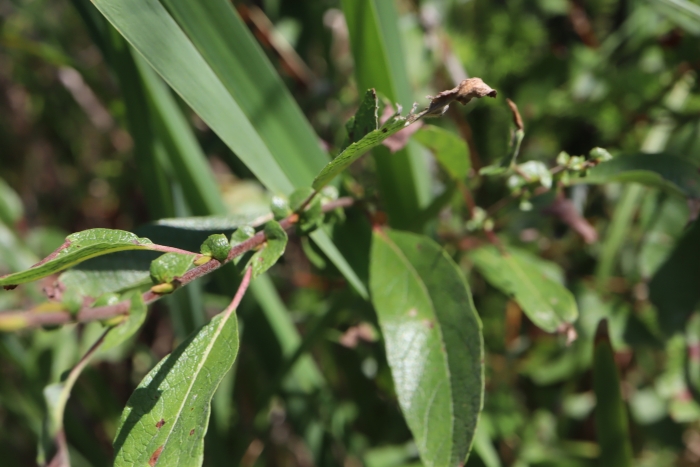Heartleaf Willow
(Salix cordata)
Heartleaf Willow (Salix cordata)
/
/

© Henry "Nick" Robertson
CC BY-SA 4.0
Image By:
© Henry "Nick" Robertson
Recorded By:
Copyright:
CC BY-SA 4.0
Copyright Notice:
Photo by: © Henry "Nick" Robertson | License Type: CC BY-SA 4.0 | License URL: http://creativecommons.org/licenses/by-sa/4.0/ | Uploader: henrythesick | Publisher: iNaturalist |










Estimated Native Range
Summary
Salix cordata, commonly known as Heartleaf Willow or Sand Dune Willow, is a deciduous shrub native to a variety of wetland habitats including riverbanks, lake shores, and wet meadows, as well as sand dunes in northeastern North America. It typically grows 3 to 12 feet tall, with most plants rarely exceeding 6 feet, and has a bushy growth form. The Heartleaf Willow is characterized by its narrow, lance-shaped leaves and yellow catkins that appear in early spring before the leaves, providing some of the earliest nectar sources for pollinators.
The Heartleaf Willow is valued for its ability to stabilize soil in its native habitat, preventing erosion along waterways and in sandy areas. It is often used in riparian restoration projects and can be planted in wet areas of the garden where other plants might struggle. This species is adaptable to a range of moisture conditions but prefers consistently moist to wet soils and full sun to partial shade. While generally low-maintenance, it can be susceptible to willow beetle and canker diseases. Gardeners should be aware that willows have aggressive roots that can interfere with underground utilities and structures.CC BY-SA 4.0
The Heartleaf Willow is valued for its ability to stabilize soil in its native habitat, preventing erosion along waterways and in sandy areas. It is often used in riparian restoration projects and can be planted in wet areas of the garden where other plants might struggle. This species is adaptable to a range of moisture conditions but prefers consistently moist to wet soils and full sun to partial shade. While generally low-maintenance, it can be susceptible to willow beetle and canker diseases. Gardeners should be aware that willows have aggressive roots that can interfere with underground utilities and structures.CC BY-SA 4.0
Plant Description
- Plant Type: Shrub
- Height: 6-12 feet
- Width: 6-12 feet
- Growth Rate: Rapid
- Flower Color: N/A
- Flowering Season: Spring, Summer
- Leaf Retention: Deciduous
Growth Requirements
- Sun: Full Sun
- Water: High
- Drainage: Medium, Slow, Standing
Common Uses
Bank Stabilization, Bird Garden, Erosion Control, Low Maintenance, Water Garden
Natural Habitat
Riverbanks, lake shores, wet meadows, and sand dunes in northeastern North America
Other Names
Common Names: Heart-leaved Willow, Blue-stem Willow, Broad Heart-Leaved Willow, Sanddune Willow, Sandbar Willow
Scientific Names: , Salix cordata, Salix adenophylla, Salix cordata var. angustifolia, Salix cordata var. brevifolia, Salix cordata var. cordata, Salix cordata var. serrata, Salix cordata var. viridula, Salix cordifolia, Salix cordifolia
GBIF Accepted Name: